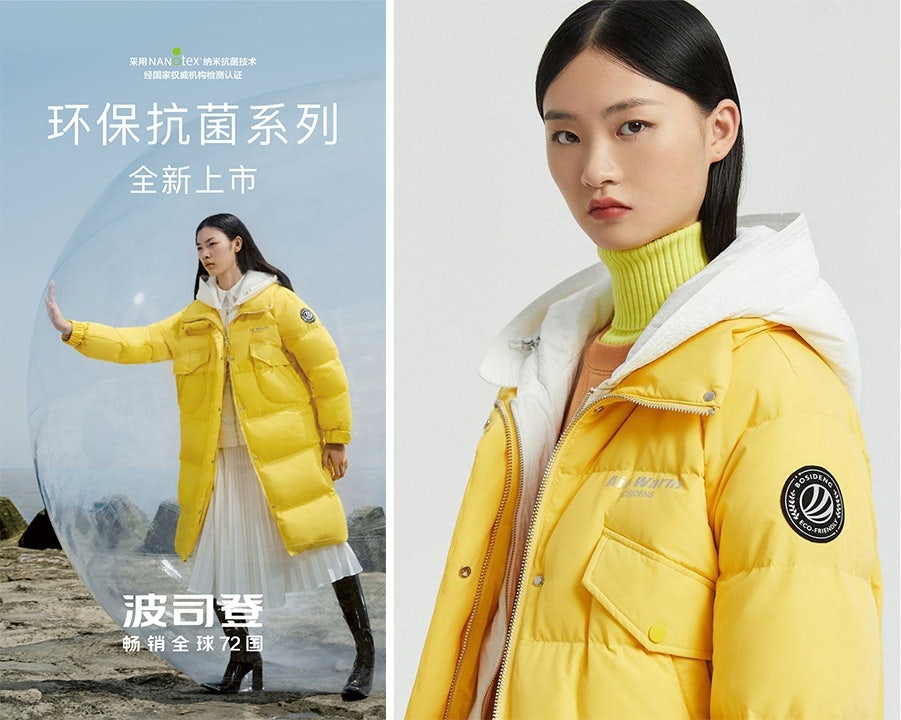Key Takeaways:#
In 2020, China’s down apparel market stood at roughly 18 billion (RMB 118.6 billion), and research conducted by the Xinsi Industrial Research Center predicts it will grow by about 11 percent over the next year to reach 22.6 billion in 2022.
Canada Goose tops the list of luxury puffer makers. Last winter, the Canadian company trended on Weibo's hot search for selling out its outerwear while the hashtag #CanadaGooseSoldOut had 240 million views.
Last year, China’s Bosideng collaborated with celebrity anchor Austin Li and actress Jing Tian for its live broadcast. That year, the homegrown puffer maker exceeded 232 million (1.5 billion RMB) in sales on the Double 11 Shopping Festival.
From Burberry to Miu Miu, luxury brands are venturing into the lucrative puffer jacket sector. Yet these fashion names account for only a small portion of the China market, worth around 18 billion (118.6 billion RMB) in 2020. In fact, the sector is largely dominated by three leading experts: Canada Goose, Moncler, and Bosideng.
The Canadian company tops the list of luxury puffer makers, and this winter, Canada Goose trended on Weibo’s hot search topics, with the hashtag #CanadaGooseSoldOut earned 240 million views. Close behind is Moncler, the stylish outerwear brand worn by numerous local celebrities. Every year, the Italian luxury skiwear name attracts long lines of young domestic consumers outside stores who rush to purchase the house’s limited-edition collaboration pieces.
Local leader Bosideng is the final part of this three-headed Oligopoly. Founded in 1975, it recently upgraded itself from an affordable line of outerwear to an industry leader. A series of transformations, including store upgrades, price increases, and designer collaborations, have helped it move into the luxury sphere and boost sales among young spenders.
But there is still much more to win in this sector. Research conducted by the Xinsi Industrial Research Center predicts this market will steadily grow by about 11 percent over the next few years, reaching a 22.6-billion value in 2022. Here, Jing Daily analyzes the strategies behind the success of the puffer market’s three biggest players.
Moncler’s Genius collaborations inspired its rivals#
In 2018, Moncler changed the puffer playbook when it introduced its Genius project, which teams the brand up with influential designers and creatives each month to create a limited-edition, co-branded capsule.
Still, Moncler Genius sales account for a relatively small portion of the company’s 1.71 billion annual revenue. “The greater significance of the projects lies in the marketing level," said the Italian group's CEO, Remo Ruffini. "It has increased brand awareness, online and offline traffic, and created millions of euros in media value.”
Even so, the success of its co-branded capsule has garnered the attention of rivals. Bosideng, for instance, used this tactic to morph into a desirable outwear name. By launching a limited-edition series with Jean-Paul Gaultier (the former creative director of Hermès), the domestic brand shifted from selling jackets priced at a few hundred yuan to garments that run for four or even five figures. As a result, it quickly grew its fan base, especially among young, local shoppers.
And this year, Canada Goose also started collaborating by tapping into the colorful streetwear of Chinese talent Angel Chen for its first team-up. And the choice of this domestic designer was highly appreciated by Mainland consumers while serving as a vehicle to reach a broader audience in Mainland China.

People appreciate the functionality of down clothing, but businesses need to stimulate customer excitement and create hot topics to retain existing consumers and attract new ones. Moncler happened to be the first in the outerwear sector to apply this collaboration model, and it became a copied formula.
Canada Goose’s pioneering fur-free commitment#
Animal rights groups have ferociously protested for years against fashion brands' use of fur. Canada Goose, in particular, was called out for its reliance on coyote fur in their famed puffers. But recently, the Canadian company announced it is making a fur-free commitment by 2022 and stopping its fur purchases by the end of 2021. This sustainability manifesto is critical to the brand's ability to retain dominance in the market.
Indeed, China’s millennials and Gen Zers, who are strong drivers of Canada Goose’s sales growth, have become increasingly concerned about the environmental and social impact of businesses today, and they are more willing to purchase from companies aligned with their values. And Bosideng’s efforts in sustainability confirm the rise of this motive in the country. During the pandemic, the down jacket maker released an environmentally friendly antibacterial series that was highly praised by local netizens. Some of them even commented that the brand “infused humanity” into its products.

Since Chinese consumers are more conscious of climate change issues, businesses must address social and environmental problems to demonstrate a commitment to this demographic. The best-performing companies in the field never go unrewarded — Canada Goose has now also harvested this pocket of animal activists.
Bosideng tops Double 11 due to online efforts#
In the first half of the 2020 fiscal year, the C-label saw its online sales increase 76.4 percent year-on-year, leading its total revenue to grow by 19.7 percent to 355 million. According to Allison Malmsten, the marketing director at the Chinese strategy agency Daxue Consulting, domestic outerwear brands like Bosideng or Peacebird threaten international brands.
Now, China-based companies are increasingly taking market shares from overseas rivals, thanks primarily to their intuitive prowess in digital innovation. In fact, these Chinese labels not only have expertise in growing their online sales channels, but they also have the advantage of having a wide network of offline stores on the Mainland (Bosideng has over a thousand directly operated stores on the Mainland while Canada Goose has fourteen).
The brand’s online success also benefits from a focus on e-commerce livestreams. In 2020, the outerwear company collaborated with celebrity anchor Austin Li and actress Jing Tian. The brand even created a virtual anchor for its Double 11 live broadcast, and its sales exceeded 232 million (1.5 billion RMB) during that year's Singles’ Day shopping festival.
For companies that want to stay relevant in China's down jacket market, Malmsten suggests brands offer “more innovations in functionality, a more diverse consumer base, distinctive and eye-catching designs, and a move from fast-fashion to high-end fashion.” That means thinking beyond seasonality, committing to sustainability initiatives, and leveraging online channels. Additionally, China’s dynamic digital ecosystem means spoiled consumers expect a 360 online experience: in other words, for a brand to be present, sell, and interact on all popular platforms.
The companies that cannot meet these requirements will lose a significant market share to native players like Bosideng. But by following the trail blazed by these three market giants, new players have a greater chance — in their own way — to take away their market shares, especially among less loyal Gen Z consumers.


